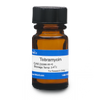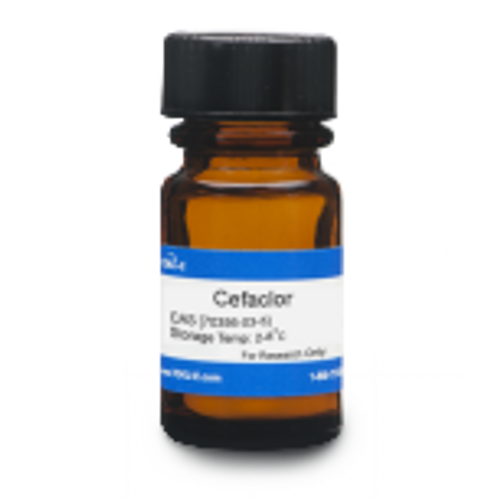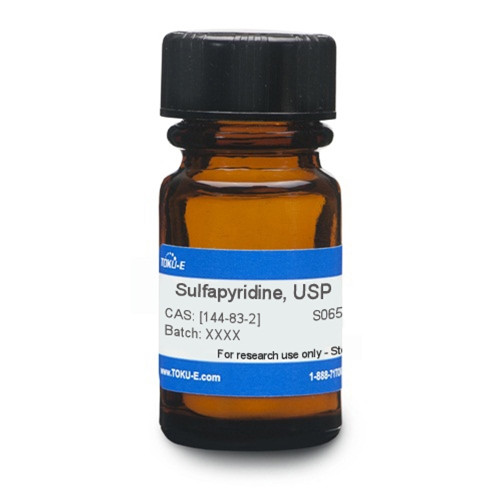Tobramycin is an aminoglycoside antibiotic derived from Streptomyces tenebrarius. Tobramycin is a member of a broad-spectrum antibiotic complex, nebramycin, that was originally isolated in 1967 by Eli Lilly and Company. The nebramycin complex was separated into various factors, with nebramycin factor 6 showing in-vitro activity of clinical usefulness. Nebramycin factor 6 was subsequently designated tobramycin.
Tobramycin is a bactericidal protein synthesis inhibitor, able to bind to the 16S rRNA of the 30S ribosomal subunit, inhibiting translocation, and eliciting miscoding of the proteins. Tobramycin has also shown a disruptive effect on the outer membrane of Gram-negative bacteria at high concentrations.
Tobramycin is active against Gram-negative bacteria and is frequently used to eliminate Pseudomonas aeruginosa in cystic fibrosis patients. Tobramycin, like other aminoglycosides, can be used to treat Gram-positive bacterial infection, but other types of antibiotics are more potent and less toxic. Tobramycin shows activity against mycobacteria but is mostly ineffective against fungi and viruses.
TOKU-E offers two forms of tobramycin:
- Tobramycin (T009)
- Tobramycin Sulfate (T010)
Both forms are soluble in aqueous solution.
| Mechanism of Action | Following active transport into the cell, tobramycin binds irreversibly to a specific aminoglycoside receptor on the bacterial 30S ribosomal subunit and interferes with the initiation complex between messenger RNA and the 30S subunit, thereby inhibiting initiation of protein synthesis, consequently leading to bacterial cell death. In addition, tobramycin induces misreading of the mRNA template causing incorrect amino acids to be incorporated into the growing polypeptide chain, consequently interfering with protein elongation. |
| Spectrum | Tobramycin is effective against aerobic, Gram-negative bacteria, like Acinetobacter and Enterobacter, but is particularly effective against Pseudomonas bacterial strains. Infections caused by Gram-positive bacteria can also be treated with aminoglycosides, like tobramycin sulfate, but other types of antibiotics are more potent and less damaging to the host. In the past, the aminoglycosides have been used in conjunction with penicillin-related antibiotics in streptococcal infections for their synergistic effects, particularly in endocarditis. Tobramycin is mostly ineffective against anaerobic bacteria, fungi, and viruses. |
| Microbiology Applications | Tobramycin is commonly used in clinical in vitro microbiological antimicrobial susceptibility tests (panels, discs, and MIC strips) against gram negative microbial isolates. Medical microbiologists use AST results to recommend antibiotic treatment options for infected patients. Representative MIC values include:
For a complete list of tobramycin MIC values, click here. It is used to treat pseudomonas aeruginosa lung infections and is used in combination with other antibiotics to treat urinary tract infections, gynecologic infections, peritonitis, endocarditis, pneumonia, sepsis, respiratory infections, osteomyelitis and other soft-tissue infections. It is a potential therapy for sinus infections. Tobramycin is used in antimicrobial resistance studies. |
| Plant Biology Applications | Tobramycin can be used to eliminate Pseudomonas aeruginosa infections in plants, soil, and water. Tobramycin has been used in conjunction with the aac(6′)-Ie/aph(2″)-Ia gene as an efficient selection system for the transformation of chloroplasts. The system’s efficiency is comparable to the selection of transplastomic lines with spectinomycin resistance conferred by the resistance gene aadA. Importantly, no spontaneous antibiotic resistance mutants appeared under tobramycin selection. Tabatabaei, I., Ruf, S., & Bock, R. (2016). A bifunctional aminoglycoside acetyltransferase/phosphotransferase conferring tobramycin resistance provides an efficient selectable marker for plastid transformation. Plant molecular biology, 93(3), 269-281. |
| Molecular Formula | C18H37N5O9 |
| References | Davis, Bernard D. "Mechanism of Bactericidal Action of Aminoglycosides."Microbiological Reviews 51.3 (1987): 341-50. |
| MIC | Bacillus cereus| 3 - ?| 1271| Bacillus subtilis (ATCC 19659)| >3 - <10| 777| Borrelia afzelii (EB1)| 32 - ?| 402| Borrelia afzelii (FEM1)| 16 - ?| 402| Borrelia afzelii (PKo)| 32 - ?| 402| Borrelia bissettii (25015)| 32 - ?| 402| Borrelia burgdorferi| 8 - 64| 402| Borrelia burgdorferi (Sensu stricto + B31)| 64 - ?| 402| Borrelia burgdorferi (Sensu stricto + LW2)| 16 - ?| 402| Borrelia burgdorferi (Sensu stricto + PKa-I)| 32 - ?| 402| Borrelia burgdorferi S.L.| 8 - 64| 1129| Borrelia garinii (G1)| 64 - ?| 402| Borrelia garinii (PSth)| 32 - ?| 402| Borrelia garinii (PTrob)| 16 - ?| 402| Borrelia valaisiana (VS116)| 64 - ?| 402| Brucella| 0.5 - 4| 1388| Burkholderia cepacia| 2 - >16| 479| Burkholderia cepacia| >64 - ?| 140| Burkholderia cepacia| 0.25 - >512| 97| Citrobacter diversus| 0.25 - 1| 1488| Citrobacter freundii| 0.12 - >64| 1467| Citrobacter freundii| 0.5 - 2| 1488| Citrobacter freundii| 97 - ?| 1132| Citrobacter koseri| 0.25 - 16| 1467| Diplococcus pneumoniae| 12.5 - 100| 1413| Enterobacter aerogenes| 0.25 - 32| 1467| Enterobacter aerogenes| 0.5 - >16| 479| Enterobacter aerogenes| 0.5 - 1| 1488| Enterobacter aerogenes| 93 - ?| 1132| Enterobacter cloacae| 0.25 - 32| 1467| Enterobacter cloacae| 0.5 - >16| 479| Enterobacter cloacae| 0.5 - ?| 1488| Enterobacter cloacae| 94 - ?| 1132| Enterobacter cloacae (ATCC 3047)| 4 - ?| 744| Enterobacteriaceae| 0.03 - 128| 401| Enterococcus faecalis (ATCC 29212)| 16 - ?| 401| Enterococcus faecium (119)| 32 - ?| 744| Escherichia coli| 0.5 - ?| 363| Escherichia coli| 95 - ?| 1132| Escherichia coli (ATCC 25922)| 0.475 - ?| 665| Escherichia coli (ATCC 25922)| 0.5 - ?| 401| Escherichia coli (ATCC 25922)| 1 - ?| 459| Escherichia coli (CTX-M-9 producing)| <0.125 - 128| 4| Escherichia coli (EC14 + Bioluminescence)| 1 - ?| 889| Escherichia coli (EC14 + Turbidity)| 1 - ?| 889| Escherichia coli (ESBL)| <0.125 - 128| 4| Escherichia coli (ESBL)| 0.5 - >16| 6| Escherichia coli (ESBL)| 0.125 - >128| 447| Escherichia coli (JM83 + AAC6'/APH2'')| 128 - ?| 744| Escherichia coli (JM83 + APH(3')-I)| 1 - ?| 744| Escherichia coli (JM83)| <1 - ?| 744| Escherichia coli (NCTC 10418)| 0.25 - ?| 401| Escherichia coli (non-ESBL)| 0.25 - 16| 6| Escherichia coli (SHV-producing)| <0.125 - 32| 4| Haemophilus influenzae| 0.4 - 1.6| 1413| Haemophilus influenzae (tobramycin-intermediate)| 8 - ?| 452| Haemophilus influenzae (tobramycin-resistant)| ≥16 - ?| 452| Haemophilus influenzae (tobramycin-susceptible)| ≤4 - ?| 452| Helicobacter pylori| 0.04 - 0.64| 662| Klebsiella oxytoca| 0.25 - 8| 1467| Klebsiella pneumonia| ≤0.25 - >16| 479| Klebsiella pneumonia| 1 - ?| 363| Klebsiella pneumonia| 95 - ?| 1132| Klebsiella pneumonia (ESBL)| 0.25 - >16| 6| Klebsiella pneumonia (non-ESBL)| 0.25 - >16| 6| Klebsiella pneumoniae| 0.12 - >64| 1467| Klebsiella pneumoniae| 0.25 - 0.5| 1488| Lactobacillus acidophilus| 4 - 32| 878| Lactobacillus brevis| 4 - 64| 878| Lactobacillus casei| 2 - >=256| 878| Lactobacillus delbrueckii| 2 - 128| 878| Lactobacillus fermentum| 4 - 128| 878| Lactobacillus plantarum| 1 - 64| 878| Lactobacillus rhamnosus| 2 - >=256| 878| Lactobacillus sp.| 1 - 256| 878| Legionella pneumophila| 0.25 - 4| 1467| Listeria monocytogenes| <=0.06 - 0.25| 1467| Listeria spp. (Etest)| 0.094 - 1.5| 848| Moraxella catarrhalis| 0.03 - 0.5| 1467| Morganella morganii| 0.25 - 32| 1467| Morganella morganii| 0.5 - >16| 479| Morganella morganii| 0.25 - 2| 1488| Mycobacterium fortuitum (ATCC 6841)| 16 - ?| 459| Mycobacterium fortuitum (ATCC 6841)| 32 - ?| 453| Neisseria spp.| 0.5 - 16| 401| Nocardia asteroides| 0.4 - >=100| 1404| Pandoraea genomo| >16 - ?| 1459| Pandoraea pnomenusa| >16 - ?| 1459| Proteus mirabilis| 0.25 - 32| 1467| Proteus mirabilis| 0.5 - >16| 479| Proteus mirabilis| 98 - ?| 1132| Proteus rettgeri| 0.5 - >16| 479| Proteus vulgaris| 0.25 - 64| 1467| Proteus vulgaris| 0.5 - 1| 1488| Proteus vulgaris| 4 - ?| 1271| Providencia spp.| 0.25 - 4| 1488| Pseudomonas aeruginosa| ≤0.25 - >16| 479| Pseudomonas aeruginosa| ? - ?| 774| Pseudomonas aeruginosa| 0.5 - 4| 1488| Pseudomonas aeruginosa| 1 - ?| 665| Pseudomonas aeruginosa| 2 - ?| 781| Pseudomonas aeruginosa| 4 - ?| 781| Pseudomonas aeruginosa| 4 - ?| 363| Pseudomonas aeruginosa| 92 - ?| 1132| Pseudomonas aeruginosa (14)| 2 - ?| 788| Pseudomonas aeruginosa (66)| 2 - ?| 744| Pseudomonas aeruginosa (ATCC 27853)| 0.5 - ?| 401| Pseudomonas aeruginosa (ATCC 27853)| 0.95 - ?| 665| Pseudomonas aeruginosa (ATCC 27853)| 2 - ?| 459| Pseudomonas aeruginosa (C43)| 4 - ?| 744| Pseudomonas aeruginosa (cbr(A) mutant)| 8 - ?| 788| Pseudomonas aeruginosa (cbr(B) mutant)| 2 - ?| 788| Pseudomonas aeruginosa (ciprofloxacin-resistant)| 2 - ?| 774| Pseudomonas aeruginosa (ciprofloxacin-susceptible)| 0.25 - >64| 1467| Pseudomonas aeruginosa (ciprofloxacin-susceptible)| 0.5 - ?| 774| Pseudomonas aeruginosa (LESB58)| 0.5 - ?| 1395| Pseudomonas aeruginosa (M18)| 0.5 - ?| 1395| Pseudomonas aeruginosa (mucoid)| 0.25 - >512| 97| Pseudomonas aeruginosa (NCTC 10662)| 0.5 - ?| 401| Pseudomonas aeruginosa (non-mucoid)| 0.5 - >512| 97| Pseudomonas aeruginosa (par(R) mutant)| 2 - ?| 781| Pseudomonas aeruginosa (par(R) mutant)| 2 - ?| 781| Pseudomonas aeruginosa (par(S) mutant)| 2 - ?| 781| Pseudomonas aeruginosa (par(S) mutant)| 2 - ?| 781| Pseudomonas aeruginosa (PYOA + tobramycin-resistant)| 8 - ?| 238| Pseudomonas aeruginosa (PYOB + mucoid phenotype)| 2 - ?| 238| Pseudomonas aeruginosa (PYOD)| 4 - ?| 238| Pseudomonas cepacia| 128 - 256| 1488| Pseudomonas spp.| 0.06 - 128| 401| Serratia marcescens| 0.5 - >16| 479| Serratia marcescens| 0.25 - >64| 1467| Serratia marcescens| 2 - >256| 1488| Serratia marcescens| 79 - ?| 1132| Serratia marcescens (ATCC 13880)| 16 - ?| 744| Staphylococci| 0.008 - 128| 401| Staphylococcus aureus| 0.25 - ?| 363| Staphylococcus aureus| 4 - ?| 1271| Staphylococcus aureus| >64 - ?| 1323| Staphylococcus aureus (3)| <1 - ?| 744| Staphylococcus aureus (ATCC 29213)| 0.5 - ?| 401| Staphylococcus aureus (ATCC 6571)| 0.12 - ?| 401| Staphylococcus aureus (ciprofloxacin-susceptible + methicillin-resistant)| 0.12 - 8| 1467| Staphylococcus aureus (methicillin-resistant)| ? - ?| 452| Staphylococcus aureus (methicillin-susceptible)| ? - ?| 452| Staphylococcus aureus (tobramycin-intermediate)| 8 - ?| 452| Staphylococcus aureus (tobramycin-resistant)| ≥16 - ?| 452| Staphylococcus aureus (tobramycin-susceptible)| ≤4 - ?| 452| Staphylococcus epidermidis| 0.06 - >32| 37| Staphylococcus epidermidis| 0.06 - >32| 37| Staphylococcus epidermidis (ciprofloxacin-susceptible + methicillin-resistant)| <=0.008 - 8| 1467| Staphylococcus haemolyticus| 0.015 - >32| 1467| Staphylococcus hominis| 0.015 - >32| 1467| Staphylococcus lugdunensis| 0.03 - >32| 1467| Staphylococcus saprophyticus| <=0.008 - 32| 1467| Staphylococcus saprophyticus (ATCC 15305)| >1 - <3| 777| Staphylococcus warneri| 0.015 - >32| 1467| Stenotrophomonas maltophilia| 2 - 0.16| 479| Stenotrophomonas maltophilia| ? - ?| 1015| Stenotrophomonas maltophilia| 31 - ?| 1132| Stenotrophomonas maltophilia (levofloxacin-susceptible)| 1 - >64| 1467| Streptococcus agalactiae| 8 - >128| 1467| Streptococcus anginosus| 0.5 - 128| 1467| Streptococcus bovis| 0.5 - 128| 1467| Streptococcus constellatus| 0.5 - 128| 1467| Streptococcus faecalis| 32 - ?| 363| Streptococcus intermedius| 0.5 - 128| 1467| Streptococcus mitis| 0.5 - 128| 1467| Streptococcus oralis| 0.5 - 128| 1467| Streptococcus pneumonia (tobramycin-intermediate)| 8 - ?| 452| Streptococcus pneumonia (tobramycin-resistant)| ≥16 - ?| 452| Streptococcus pneumonia (tobramycin-susceptible)| ≤4 - ?| 452| Streptococcus pneumoniae (levofloxacin-susceptible)| 4 - 32| 1467| Streptococcus pyogenes| 4 - 64| 1467| Streptococcus salivarius| 0.5 - 128| 1467| Streptococcus sanguinis| 0.5 - 128| 1467| Xanthomonas maltophilia| 2 - >256| 1488| |








